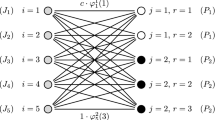Abstract
A parallel computational model is defined which addresses I/O contention,latency, and pipe-lined message passing between tasks allocated to differentprocessors. The model can be used for parallel task-allocation on either anetwork of workstations or on a multi-stage inter-connected parallel machine.To study performance bounds more closely, basic properties are developed forwhen the precedence constraints form a directed tree. It is shown that theproblem of optimally scheduling a directed one-level precedence tree on anunlimited number of identical processors in this model is NP-hard. Theproblem of scheduling a directed two-level precedence tree is also shown tobe NP-hard even when the system latency is zero.
An approximation algorithm is then presented for scheduling directedone-level task trees on an unlimited number of processors with anapproximation ratio of 3. Simulation results show that this algorithm is, infact, much faster than its worst-case performance bound. Better simulationresults are obtained by improving our approximation algorithm usingheusistics. Restricting the problem to the case of equal task executiontimes, a linear-time algorithm is presented to find an optimal schedule.
Similar content being viewed by others
References
F.D. Anger, J.J. Hwang, and Y.C. Chow, “Scheduling with sufficient loosely coupled processors,” Journal of Parallel and Distributed Comput., vol. 9, pp. 87–92, 1990.
T.C.E. Cheng and C.C.S. Sin, “A state-of-the-art review of parallel-machine scheduling research,” European J. Operational Research, vol. 47 pp. 271–292, 1990.
P. Chrétienne, “A polynomial algorithm to optimally schedule tasks on a virtual distributed system under tree-like precedence constraints,” European J. Operational Research, vol. 43, pp. 225–230, 1989.
P. Chrétienne, “Task scheduling with interprocessor communication delays,” European J. Operational Research, vol. 57, pp. 348–354, 1992.
P. Chrétienne, “Tree scheduling with communication delays,” Discrete Applied Math., vol. 49, pp. 129–141, 1994.
P. Chrétienne, Jr., E.G. Coffman, J.K. Lenstra, and Z. Liu (Eds.), Scheduling Theory and its Applications, John Wiley & Sons Ltd., 1995.
J.Y. Colin and P. Chrétienne, “C.P.M. scheduling with small communication delays and task duplication,” Oper. Res., vol. 39, no. 3, pp. 680–684, 1991.
D. Culler, R. Karp, D. Patterson, A. Sahay, K.E. Schauser, E. Santos, R. Subramonian, and T. von Eicken, “LogP: Towards a realistic model of parallel computation,” in Proc. 4th ACM SIGPLAN Symp. on Principles and Practices of Parallel Programming, 1993, pp. 1–12.
O. El-Dissouki and W. Huen, “Distributed enumeration on network computers,” IEEE Trans. on Computers, vol. C-29, no.9, pp. 818–825, 1980.
M.R. Garey and D.S. Johnson, COMPUTERS AND INTRACTABILITY A Guide to the Theory of NP -Completeness, W.H. Freeman and Company: New York, 1979.
A. Geist, A. Beguelin, J. Dongarra, W. Jiang, R. Manchek, and V. Sunderam, PVM 3 User’s Guide and Reference Manual, Oak Ridge National Laboratory: Oak Ridge, Tennessee 37831, USA, May 1993.
P.B. Gibbons, Y. Matias, and V. Ramachandran, “The QRQW PRAM: Accounting for contention in parallel algorithms, in Proc. 5th ACM-SIAM Symp. on Discrete Algorithms, 1994, pp. 638–648. SIAM J. Comput., to appear.
J.J. Hwang, Y.C. Chow, F.D. Anger, and C.Y. Lee, “Scheduling precedence graphs in systems with interprocessor communication times,” SIAM Journal on Computing, vol. 18, no.2, pp. 244–257, 1989.
J.K. Lenstra, M. Veldhorst, and B. Veltman, “The complexity of scheduling trees with communication delays,” J. of Algorithms, vol. 20, pp. 157–173, 1996.
V.M. Lo, Task Assignment in Distributed Systems, Ph.D. thesis, Univ. of Illinois at Urbana-Champaign, USA, Oct. 1983.
V.M. Lo, “Heuristic algorithms for task assignment in distributed systems,” IEEE Trans. on Computers, vol. 37, no. 11, pp. 1284–1397, 1988.
D.R. Lopez, Models and Algorithms for Task Allocation in a Parallel Environment, Ph.D. thesis, Texas A&M University, Texas, USA, Dec. 1992.
P.R. Ma, E.Y. Lee, and M. Tsuchiya, “A task allocation model for distributed computing systems,” IEEE Trans. on Computers, vol. C-31, no.1, pp. 41–47, 1982.
M.G. Norman and P. Thanisch, “Models of machines and computation for mapping in multicomputers,” ACM Computing Surveys, vol. 25, no.3, pp. 263–302, 1993.
C. Papadimitriou and M. Yannakakis, “Towards on an architecture-independent analysis of parallel algorithms,” SIAM Journal on Computing, vol. 19, pp. 322–328, 1990.
H.S. Stone, “Multiprocessor scheduling with the aid of network flow algorithms,” IEEE Trans. on Software Eng., vol. SE-3, no.1, pp. 85–93, 1977.
L.G. Valiant, “A bridging model for parallel computation,” Communications of the ACM, pp. 103–111, 1990a.
L.G. Valiant, “General purpose parallel architectures,” in Handbook of Theoretical Computer Science, J. van Leeuwen (Ed.), North Holland, pp. 944–971, 1990b.
Author information
Authors and Affiliations
Rights and permissions
About this article
Cite this article
Hollermann, L., Hsu, Ts., Lopez, D.R. et al. Scheduling Problems in a Practical Allocation Model. Journal of Combinatorial Optimization 1, 129–149 (1997). https://doi.org/10.1023/A:1009799631608
Issue Date:
DOI: https://doi.org/10.1023/A:1009799631608




